Field Offset Dependencies 
You can also add a Field Offset Dependency when you select Dependencies on the Home tab, in the Setup group, prior to visualising them in the Animation Window.
Field Offset dependencies allow you to define complex patterns in your dependencies by using Field positions rather than Level positions. To offset dependencies by mining stage, you might decide to add a Stage attribute field to your Table Data, for example.
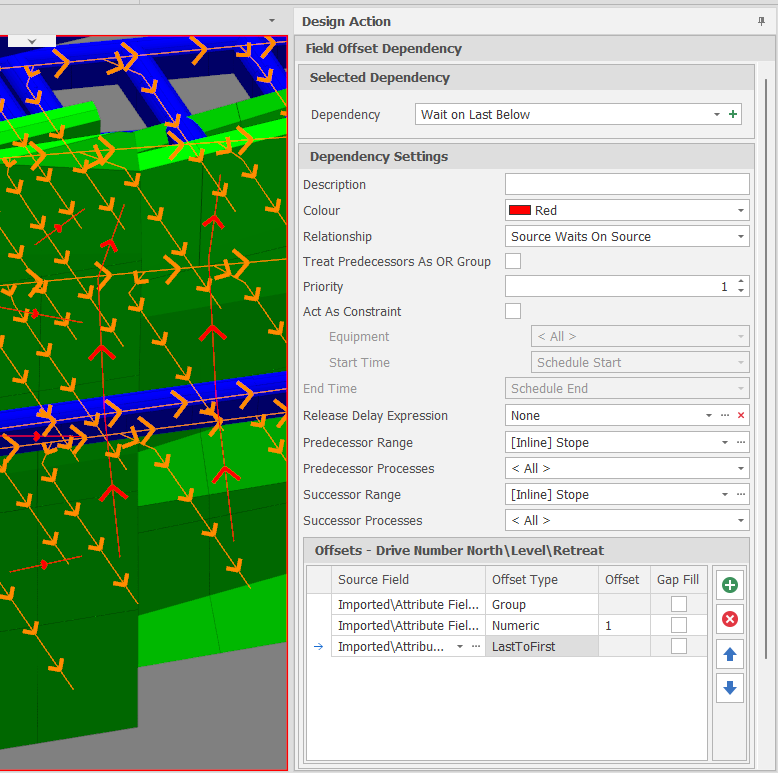
Create Field Offset Dependencies
Select Dependency
Select an existing Field Offset Dependency. You can right-click in the Dependency Selection pane to Insert Copy, Rename or Delete a dependency.
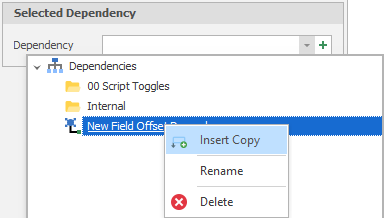
Create New
Alternatively, right-click and select Add to create a new Field Offset Dependency from scratch:

The Field Offset Dependency that you Name here is added to the root Dependencies folder (or a sub folder if you specify one).
Dependency Settings
When you add or edit a Dependency of this type, you can set the following parameters (or accept the defaults where applicable):
Description
Optionally, enter a Description that can be used with the Name to further identify the Dependency. Detail useful for diagnosing issues with Dependencies should be added here.
Colour
Use the drop-down to differentiate this type of dependency by colour in the Animation Window.
Relationship
The Predecessor to Successor Relationship. Defaults to Source Waits on Source. Source Waits On Destination means a Source Task is waiting on a Destination Task to be finished.
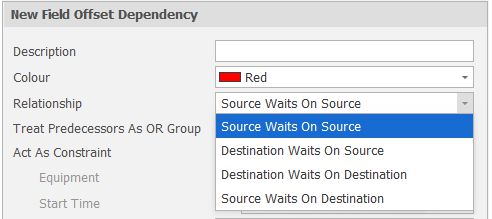
Treat Predecessors as OR Group
Where multiple predecessor tasks have the same successor task and the OR check box is NOT enabled, the successor task will only be released after ALL of the predecessor tasks are completed.
Where multiple predecessor tasks have the same successor task and the OR check box is enabled, then the successor task will be released when ANY of the predecessor tasks are completed.
Priority
The Priority is a numerical method to classify your dependencies by importance. Ranges with Priority 1 will be resolved first, meaning if there are conflicting dependencies between two or more ranges, ranges with lower priority will become circular, rather than randomly resolving the conflict.
Act As Constraint
Normally a Dependency takes into consideration the relationship between Tasks regardless of the Equipment or Date involved. Selecting the Act As Constraint check box
For example, if the user ticks act as constraint in the dependency range, and excludes Drills, the Drills will not honour the dependency range.
Release Delay Expression
The key terminology to be aware of is Released (no Dependency on this Task) and Unreleased (Waiting on Dependency). This will become useful in the Snapshot Viewer and how it can help diagnose issues with Source Paths and Dependencies.
Once a Predecessor Range has been completed, the Release Delay controls how long until the Successor Range is considered "Released" and can be worked. Accept the default (None) or build a Release Delay Expression using the operators, constants and functions provided by the Expression Editor.
Predecessor/Successor Range
This is where you enter the Dependency text. For example:
Predecessor: MyPit/S1/B1-B10/A-F
Successor: MyPit/S1/B1-B10/G
Predecessor/Successor Processes
Allows you to control which Processes are used for the Dependency.
Offsets
Source Field
Select the fields whose values you want to offset.
Offset Type
Use the drop-down to select an Offset Type for each field:
| Type | Description |
|---|---|
|
Numeric |
Offset this level by a fixed value/values. |
|
|
For example, an Offset value of 1 means "next position", an Offset value of -1 means "previous position", and an Offset value of * means "all positions". |
|
Group |
Offset is set to 0, which means "same". |
|
|
For example, an Offset Type of Group is set for the field Level. An Offset Type of Numeric and an Offset value of negative 1 is set for the field Drive Number North. Effectively, we're looking at one level and looking one drive back. |
|
FirstToLast |
The only dependency that can exist is where the predecessor is the first in its group at this level, and the successor is the last in its group at this level. |
|
LastToFirst |
The only dependency that can exist is where the predecessor is the last in its group at this level and the successor is the first in its group at this level. |
Gap Fill
Depending on the Offset Type and values entered and the Source Field selected, ascending or descending numbering rules are used to step through the dependency chain. Select the Gap Fill check box to search beyond any gaps in the numbered sequence of field values.
For example, if Benches have an ascending value in a Bench Num Field of 1,2,3,6,7,9,10 without applying the Gap Fill search box, a 1 Offset would connect benches between 1-3 and 9-10 only. However, if the Gap Fill search box was ticked, with the same 1 Offset rule, all benches would be connected, from 1 to 10.
The Offset fields you have selected are shown at the top of the Offsets pane:

Note: If field values are numeric, positions are sorted numerically, i.e. 1,2,3,4,5,6, etc. If field values are alphabetic, positions are sorted alphabetically, i.e. A, B, C, D, E, etc. If field values are alphanumeric, positions are sorted alphanumerically, i.e. 10A, 10B, 1A, 1B, 2A, 2B, etc.
Visualisation
Click the Preview/Clear Preview button to preview/clear the dependencies created from the specified Predecessor/Successor Ranges, Processes and Field Offsets:
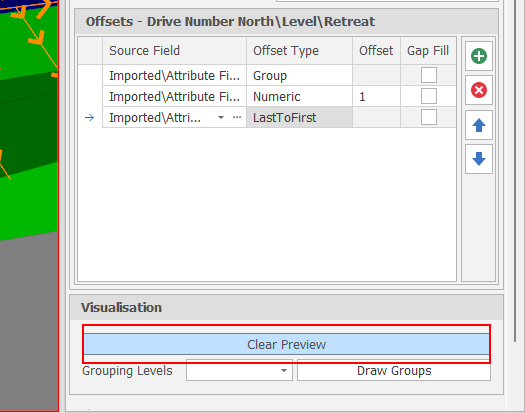
Grouping Levels
Select grouping levels based on one or more of the Offset fields you have selected:
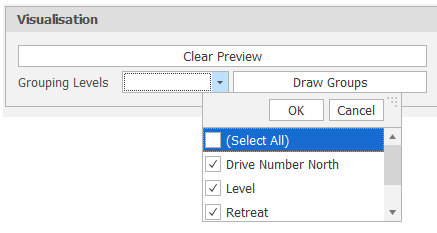
Draw Groups
The grouping levels available are the same as the ones selected for the Offsets rules. For example, if the user has Retreat, Level and Drive Number North in the Source Fields, these fields can also be selected for Grouping levels. Click this button to see a colour-coded representation of those groups.
You can then click the same button to Clear Drawn Groups:
You can also use Modify Range Dependency By Animation to set dependencies interactively in the Animation Window